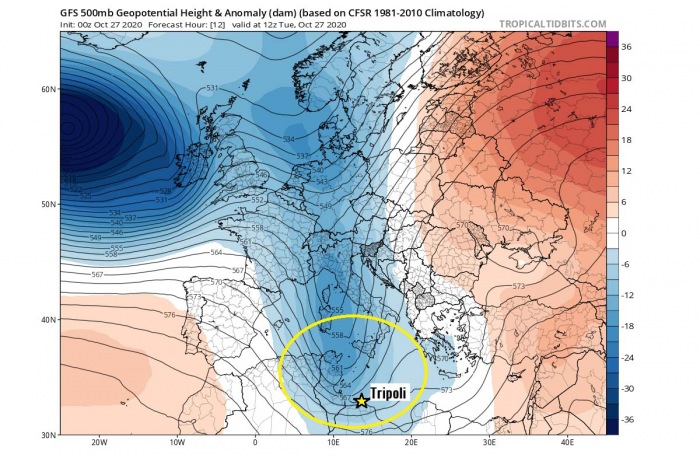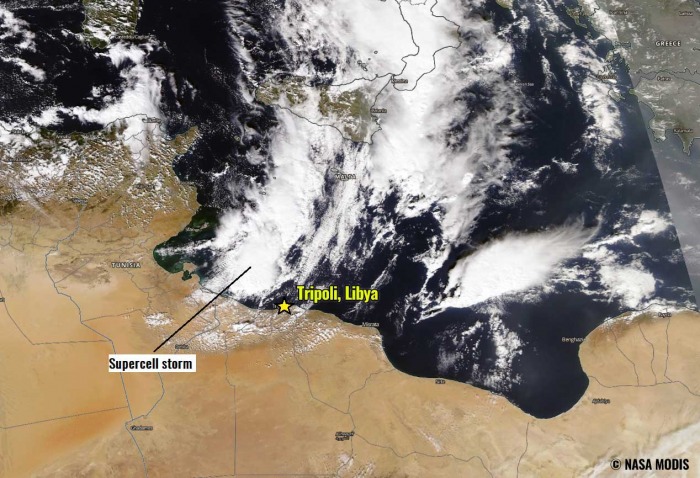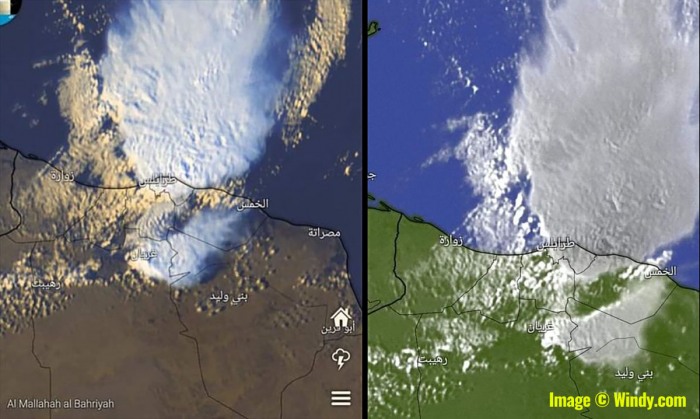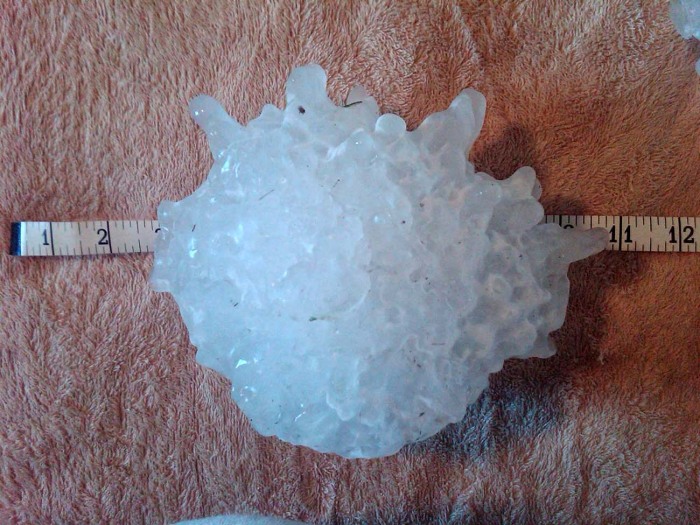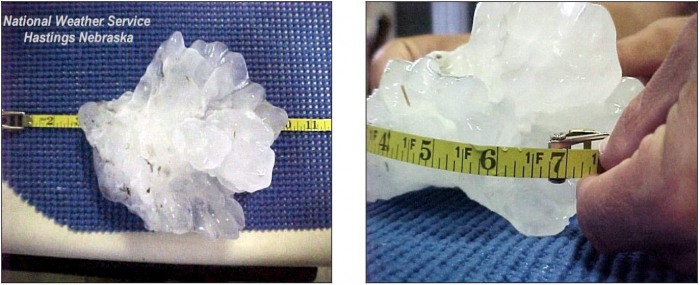The capital of Libya, Tripoli has been hit by an unprecedented severe supercell storm on Tuesday, Oct 27th, 2020. The storm produced exceptionally large, *giant* hail, possibly more than 8 inches (20 cm) in diameter. The first reports indicate that hailstones could be one of the largest ever recorded on Earth!
Such hail size would definitely fit into the world’s Top 3 giant hailstone events reported globally. Besides the Vivian (south Dakota) hailstorm from 2010 and the so-called ‘gargantuan’ hailstorm in Argentina in 2018.
EVENT ANALYSIS
The event occurred on Tuesday afternoon (Oct 27th) when an upper trough was moving across the Mediterranean. A trough axis with a frontal boundary was moving from west to east across the southern portions of the Mediterranean sea.
And one of the storms along the front brought an intense organized storm in the early evening hours. Social media were soon flooded with numerous giant hail reports!
Conditions ahead and along the front very strongly supportive of severe weather, with very high to extreme instability within a strongly sheared environment. The winds ahead of the trough, strengthening with height, favored organized convective storms. Including rotating, supercell storms.
A band of convective storms was moving along the front, as seen by the NASA MODIS satellite image below. A discrete supercell storm can be analyzed at the tail-end of the storm.
Tail-end storms tend to be the strongest and most organized in the line as they have the best conditions available for their organization.
Based on the clouds visible over northern Libya, there was likely a north-northeasterly moist inflow advecting from the warm Mediterranean sea further inland. This normally provides backing winds near the surface, which supports an important ingredient, the wind shear.
The attached sounding (Skew-T) diagram is, however, only a forecast (not the real observation) for the northern coast of Libya where the severe supercell hit. Nevertheless, we can easily see the wind shear was very strong, while instability was 2000 J/kg and beyond. While the mid-levels were rather dry.
Attached is the satellite image in a visible channel at the time the supercell was grazing the coastal areas of northern Libya, right over the capital city of Tripoli. The image indicated the classic satellite presentation of a strongly organized supercell storm, with textbook overshooting top* present.
*Overshooting top is a sign that extremely unstable air mass is present and very large hail is likely occurring.
The below photo material is beyond exceptional. A person is holding these giant hailstones which seem to be easily past the 15 cm (6 inches) to near 8 inches (20 cm) in diameter. Or even more.
Here is a short analysis by dr. Mateusz Taszarek. Analysis hints that the hailstones were exceptionally large, potentially even greater than 8 inches (20 cm) in diameter.
Mateusz noted:
“My rough estimate of Libyan hail size. Considering that this person had a slim hand, a preliminary estimate gives ~20cm (~ 24cm if that was adult). A comparison to my hand indicates 21-22cm. In my view, this hail had at least 18-20cm what makes it probably a near world record size!”
Here are also several videos of the event – the first one is extreme. Listen to the hail bombardment!
Hailstorm in Tripoli, Libya by Ayhan Erdoğan
Imagine a melon-sized chunk of ice falling out of the sky? Punching a hole in your car windshield? Yes, hail can grow that big!
Hail is one of the biggest hazards with severe thunderstorms – while it is usually small and relatively harmless, it may grow to tennis ball-sized or even larger.
Hailstorms can cause destructive damage to crops, livestock, structures, and cars. It may even injure people and in extreme cases, it can also result in deadly cases.
HOW HAIL ACTUALLY FORMS?
Hail or a hailstone forms as supercooled water droplets within a thunderstorm updraft begin freezing onto a condensation nucleus. The supercooled droplets have a temperature below freezing (0 °C or 32 °F), but still in a liquid state.
As they come into contact with the growing hailstone, they freeze onto it, making it grow larger. The growing hailstone is kept in the air by the storm’s updraft until it grows too big and heavy for the upward wind to keep it aloft.
The hailstone may make a single round within the updraft of the storm, but often it makes several rounds within the updraft. Each round results in the formation of a new layer of ice around the chunk of ice, producing a concentric onion-like structure.
Some hailstones form and grow by many smaller hailstones sticking and freezing together into a large hailstone – such form is called an agglomerate. The largest hailstones sometimes even form long icy horns or spikes!
The most severe hailstorms and largest hail are usually associated with supercell thunderstorms. It takes very high to extreme instability, strong wind shear, and dry mid-levels for very large hail to form.
But just how big and heavy can hailstones grow? Below are some of the records for the largest, the heaviest, and the deadliest hailstorms around the world.
LARGEST (DIAMETER) HAILSTONE EVER RECORDED
Villa Carlos Paz, Argentina – Feb 8th, 2018
On the 8th of February, 2018, gigantic chunks of ice were falling down from the sky in Villa Carlos Paz, a resort city west of Córdoba, Argentina. A supercell thunderstorm bombarded the city center.
Researchers investigating the 2018 storm found that one of the hailstones had a diameter between 7.4 inches (18.8 cm) and 9.3 inches (23.6 cm) across. This diameter may approach or even exceed the official world record for biggest hail – recorded in Vivian, South Dakota (see below).
The hailstones were so large that scientists suggested a new category to describe them — a ‘gargantuan hail‘.
Based on the official reports, this so-called ‘gargantuan’ hailstone that fell in Argentina may beat the actual world record, according to researchers. But these reports have not been officially confirmed yet.
According to the National Oceanic and Atmospheric Administration (NOAA), the official world record for the largest hailstone belongs to an 8-inch (20.3 cm) hailstones that fell near Vivian, South Dakota, the United States in 2010.
Vivian, South Dakota – July 23rd, 2010
On July 23rd, 2010 an 8.0 inches (20.3 cm) hailstone was recorded in the severe hailstorm produced by the Vivian, South Dakota severe supercell. The hailstone was found by Mr. Lee Scott, and it had the size of a volleyball!
The hailstone had a circumference of 18.625 inches (47.3 cm) and a weight of 1.9375 pounds (0.88 kg). It produced an impact pit about 10 inches (25 cm) across on the ground.
Here is the radar animation of a severe hailstorm near Vivian, South Dakota on July 23rd, 2010.
There are other, unconfirmed reports of similarly sized hail found. For example, Ponca City, Oklahoma is reported to have been hit by up to 8 inches (20 cm) hailstones on April 17th, 1935.
LARGEST (CIRCUMFERENCE) HAILSTONE EVER RECORDED
Aurora, Nebraska – June 22nd, 2003
An 18.75 inches (47.6 cm) circumference hailstone was recorded on June 22nd, 2003 on a severe thunderstorm that hit Aurora, Nebraska, United States. The hailstone was 7.0 inches (17.8 cm) in diameter, but no weight was officially recorded as the hailstone partially broke off as it hit the roof of a house.
It is noteworthy, that the hail that hit Hamilton County (including Aurora) produced impact pits on the ground up to 14.1 inches (36 cm) across.
In Europe, the largest reported hailstone diameters in recent years are 15 cm on June 20th, 2016 in Sânandrei, western Romania, and 14.1 cm on August 6th, 2013 in Undingen in southwestern Germany. 14 cm hailstones were also reported in Stari Trg ob Kolpi, Slovenia on June 11th, 2019.
This year, one giant hail event was also reported in Slovenia, the city of Domzale was hit by 10+ cm hailstones: Destructive hailstorm in central Slovenia, July 29th – the first 10+ cm *giant* hail event in Europe this summer.
HEAVIEST HAILSTONE EVER RECORDED
Gopalganj district, Bangladesh – April 14th, 1986
The heaviest hailstone that has been authenticated by official authorities fell during a severe hailstorm in the Gopalganj district of Bangladesh on April 14th, 1986. It weighed in at 2.25 pounds (1.0 kg).
The intense hailstorm killed 92 people.
In Europe, the record is held by a large, 2.1 pounds (0.97 kg) hailstone that fell in Strasbourg, France on August 11, 1958 – unfortunately, no dimensions were recorded.
BIGGEST HAIL ACCUMULATION ON THE GROUND EVER RECORDED
Seldon, Kansas – June 3rd, 1959
A persistent, virtually stationary hailstorm hit Seldon, Kansas on June 3, 1959. It produced a blanket of hail up to 18 inches (45 cm) thick over an area of (54 sq miles) 140 square kilometers.
DEADLIEST HAILSTORM
Moradabad & Beheri districts, India – April 22nd, 1888
April 22, 1888, Moradabad & Beheri districts, India is the deadliest hailstorm in recorded modern history, with 246 fatalities.
See additional information in some other hail reports:

